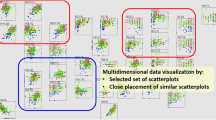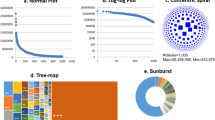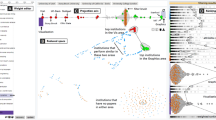Abstract
Star glyph is widely used as a typical radial plot to visualize multi-dimensional data, allowing the comparison of multiple attributes while displaying them. Though many alternative designs for star glyphs exist, there is no experimental evidence for the impact of the encoding methods in understanding and comparing multi-dimensional values. This paper reports a controlled user experiment exploring the effect of fundamental design parameters of star glyphs on efficiency and accuracy. Three design parameters (position, length, and area) were tested through four tasks (finding extremes, retrieving values, comparing values of adjacent attributes, and comparing values of non-adjacent attributes) with two dimensions (low and high). In general, the results show a significant difference in efficiency in the tasks of finding extremes, comparing values for both adjacent attributes and non-adjacent attributes for the design parameter of area encoding and length encoding. Length encoding can improve the efficiency of judgment in all comparison tasks. However, surprisingly, in the finding extremes task, the augmented points affect users’ efficiency on tasks with high dimensions. In terms of accuracy, no significant difference was observed among the different design parameters in all tasks. Furthermore, we report the strategies participants used in completing the tasks, users’ preference of different designs, and the level of confidence in making decisions. Based on these findings, we propose design considerations for star glyphs regarding the effect of different parameters.
Graphical abstract









Similar content being viewed by others
References
Albo Y, Lanir J, Bak P, Rafaeli S (2015) Off the radar: comparative evaluation of radial visualization solutions for composite indicators. IEEE Trans Vis Comput Graph 22(1):569–578
Amar R, Eagan J, Stasko J (2005) Low-level components of analytic activity in information visualization. IEEE Symp Inf Vis 2005:111–117
Borgo R, Kehrer J, Chung DH, Maguire E, Laramee RS, Hauser H, Ward M, Chen M (2013) Glyph-based visualization: foundations, design guidelines, techniques and applications. Eurographics (State of the Art Reports), pp 39–63
Brehmer M, Munzner T (2013) A multi-level typology of abstract visualization tasks. IEEE Trans Vis Comput Graph 19(12):2376–2385
Cai X, Efstathiou K, Xie X, Wu Y, Shi Y, Yu L (2018) A study of the effect of doughnut chart parameters on proportion estimation accuracy. Comput Graph Forum 37:300–312
Caporaso T, Grazioso S, Di Gironimo G, Lanzotti A (2020) Biomechanical indices represented on radar chart for assessment of performance and infringements in elite race-walkers. Sports Eng 23(1):1–8
Chambers JM, Cleveland WS, Kleiner B, Tukey PA (2018) Graphical methods for data analysis. Chapman and Hall, CRC
Chen Z, Zeng W, Yang Z, Yu L, Fu C-W, Qu H (2020) Lassonet: deep lasso-selection of 3D point clouds. IEEE Trans Vis Comput Graph 26(1):195–204. https://doi.org/10.1109/TVCG.2019.2934332
Cleveland WS, McGill R (1984) Graphical perception: theory, experimentation, and application to the development of graphical methods. J Am Stat Assoc 79(387):531–554
Deng Z, Weng D, Xie X, Bao J, Zheng Y, Xu M, Chen W, Wu Y (2021) Compass: towards better causal analysis of urban time series. IEEE Trans Vis Comput Graph 28(1):1051–1061
Draper GM, Livnat Y, Riesenfeld RF (2009) A survey of radial methods for information visualization. IEEE Trans Vis Comput Graph 15(5):759–776
Dy B, Nazim I, Poorthuis A, Joyce SC (2021) Improving visualisation design for effective multi-objective decision making. IEEE Trans Vis Comput Graph. https://doi.org/10.1109/TVCG.2021.3065126
Fuchs J (2015) Glyph design for temporal and multi-dimensional data: design considerations and evaluation. PhD thesis
Fuchs J, Isenberg P, Bezerianos A, Fischer F, Bertini E (2014) The influence of contour on similarity perception of star glyphs. IEEE Trans Vis Comput Graph 20(12):2251–2260
Healey CG, Booth KS, Enns JT (1996) High-speed visual estimation using preattentive processing. ACM Trans Comput Hum Interact 3(2):107–135
Heckert NA, Filliben JJ, Croarkin CM, Hembree B, Guthrie WF, Tobias P, Prinz J, et al (2002) Handbook 151: nist/sematech e-handbook of statistical methods
Hongliang L, Anxin L, Bin Z, Tiefu Z, Xin Z (2008) A fuzzy comprehensive evaluation method of maintenance quality based on improved radar chart. Int Colloq Comput Commun Control Manag 1:638–642
Kandogan E (2000) Star coordinates: a multi-dimensional visualization technique with uniform treatment of dimensions. IEEE Inf Vis Symp 650:9–12
Klippel A, Hardisty F, Li R, Weaver C (2009) Colour-enhanced star plot glyphs: can salient shape characteristics be overcome? Cartogr Int J Geogr Inf Geovisualization 44(3):217–231
Klippel A, Hardisty F, Weaver C (2009) Star plots: how shape characteristics influence classification tasks. Cartogr Geogr Inf Sci 36(2):149–163
Li J, Martens J-B, van Wijk JJ (2010) A model of symbol size discrimination in scatterplots. In Proceedings of the SIGCHI Conference on Human Factors in Computing Systems, pp. 2553–2562
Liu S, Peng D, Zhu H, Wen X, Zhang X, Zhou Z, Zhu M (2021) Muluba: multi-level visual analytics of user behaviors for improving online shopping advertising. J Vis 24(6):1287–1301
Opach T, Popelka S, Dolezalova J, Rød JK (2018) Star and polyline glyphs in a grid plot and on a map display: which perform better? Cartography and Geographic Information Science 45(5):400–419
Peng W, Li Y, Fang Y, Wu Y, Li Q (2019) Radar chart for estimation performance evaluation. IEEE Access 7:113880–113888
Peng W, Ward MO, Rundensteiner EA (2004) Clutter reduction in multi-dimensional data visualization using dimension reordering. In IEEE Symposium on Information Visualization, IEEE, pp 89–96
Saary MJ (2008) Radar plots: a useful way for presenting multivariate health care data. J Clin Epidemiol 61(4):311–317
Seide SE, Jensen K, Kieser M (2021) Utilizing radar graphs in the visualization of simulation and estimation results in network meta-analysis. Res Synth Methods 12(1):96–105
Skau D, Kosara R (2016) Arcs, angles, or areas: individual data encodings in pie and donut charts. Comput Graph Forum 35(3):121–130
Stafoggia M, Lallo A, Fusco D, Barone AP, D’Ovidio M, Sorge C, Perucci CA (2011) Spie charts, target plots, and radar plots for displaying comparative outcomes of health care. J Clin Epidemiol 64(7):770–778
Tominski C, Abello J, Schumann H (2004) Axes-based visualizations with radial layouts. In Proceedings of the ACM symposium on Applied computing, pp 1242–1247
Wei Y, Mei H, Zhao Y, Zhou S, Lin B, Jiang H, Chen W (2020) Evaluating perceptual bias during geometric scaling of scatterplots. IEEE Trans Vis Comput Graph 26(1):321–331. https://doi.org/10.1109/TVCG.2019.2934208
Wilkinson L (2012) The grammar of graphics. Handbook of computational statistics. Springer, pp 375–414
Wu A, Qu H (2018) Multimodal analysis of video collections: visual exploration of presentation techniques in ted talks. IEEE Trans Vis Comput Graph 26(7):2429–2442
Xia J, Lin W, Jiang G, Wang Y, Chen W, Schreck T (2021) Visual clustering factors in scatterplots. IEEE Comput Graph Appl 41(5):79–89. https://doi.org/10.1109/MCG.2021.3098804
Xia J, Zhang Y, Song J, Chen Y, Wang Y, Liu S (2022) Revisiting dimensionality reduction techniques for visual cluster analysis: an empirical study. IEEE Trans Vis Comput Graph 28(1):529–539. https://doi.org/10.1109/TVCG.2021.3114694
Yuan J, Chen C, Yang W, Liu M, Xia J, Liu S (2021) A survey of visual analytics techniques for machine learning. Comput Vis Media 7(1):3–36. https://doi.org/10.1007/s41095-020-0191-7
Zeng W, Fu C-W, Müller Arisona S, Schubiger S, Burkhard R, Ma K-L (2017) Visualizing the relationship between human mobility and points-of-interest. IEEE Trans Intell Transp Syst 18(8):2271–2284. https://doi.org/10.1109/TITS.2016.2639320
Zhang C, Zeng W, Liu L (2021) Urbanvr: an immersive analytics system for context-aware urban design. Comput Graph 99:128–138. https://doi.org/10.1016/j.cag.2021.07.006
Zhao Y, Luo F, Chen M, Wang Y, Xia J, Zhou F, Wang Y, Chen Y, Chen W (2019) Evaluating multi-dimensional visualizations for understanding fuzzy clusters. IEEE Trans Vis Comput Graph 25(1):12–21. https://doi.org/10.1109/TVCG.2018.2865020
Zhao Y, Shi J, Liu J, Zhao J, Zhou F, Zhang W, Chen K, Zhao X, Zhu C, Chen W (2021) Evaluating effects of background stories on graph perception. IEEE Trans Vis Comput Graph. https://doi.org/10.1109/TVCG.2021.3107297
Acknowledgements
The work was supported by NSFC (62272396) and XJTLU Research Development Funding RDF-19-02-11.
Author information
Authors and Affiliations
Corresponding author
Additional information
Publisher's Note
Springer Nature remains neutral with regard to jurisdictional claims in published maps and institutional affiliations.
Yihan Hou conducted this research while affiliated with Xi’an Jiaotong-Liverpool University.
Supplementary Information
Below is the link to the electronic supplementary material.
Rights and permissions
Springer Nature or its licensor holds exclusive rights to this article under a publishing agreement with the author(s) or other rightsholder(s); author self-archiving of the accepted manuscript version of this article is solely governed by the terms of such publishing agreement and applicable law.
About this article
Cite this article
Hou, Y., Zhu, H., Liang, HN. et al. A study of the effect of star glyph parameters on value estimation and comparison. J Vis 26, 493–507 (2023). https://doi.org/10.1007/s12650-022-00888-x
Received:
Accepted:
Published:
Issue Date:
DOI: https://doi.org/10.1007/s12650-022-00888-x




